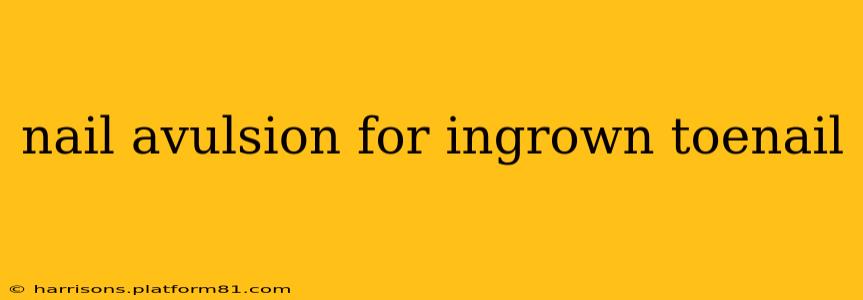An ingrown toenail, a common and often painful condition, occurs when the edge of a toenail grows into the surrounding skin. While minor cases can be treated at home, severe ingrown toenails may necessitate a procedure called nail avulsion. This comprehensive guide explores nail avulsion for ingrown toenails, detailing the procedure, recovery, and alternative treatments.
What is Nail Avulsion?
Nail avulsion is a surgical procedure where a portion or the entire toenail is removed. It's a last resort for managing severe ingrown toenails that haven't responded to conservative treatments. The procedure aims to alleviate pain, prevent infection, and promote healing. The severity of the ingrown toenail dictates the extent of the removal – sometimes just a small section of the nail is removed, while in other cases, the entire nail may need to be extracted.
When is Nail Avulsion Necessary?
Nail avulsion is considered when less invasive methods have failed to provide relief. These less invasive methods often include:
- Soaking the foot in warm, soapy water: This helps to soften the skin and nail, making it easier to manage.
- Lifting the ingrown edge of the nail: A small piece of cotton can be carefully inserted under the ingrown nail edge to help it lift away from the skin.
- Oral antibiotics: These are prescribed to combat infection if present.
- Topical creams: These may help reduce pain and inflammation.
If these methods don't resolve the issue, significant pain persists, a severe infection develops, or there's excessive granulation tissue (excessive healing tissue), nail avulsion may be recommended.
What Happens During a Nail Avulsion Procedure?
The procedure usually takes place in a doctor's office or a clinic under local anesthesia. The area is numbed, ensuring minimal discomfort. The doctor will then carefully remove the affected portion of the toenail using surgical instruments. In cases of complete avulsion, the entire nail is removed. Following the removal, the area is cleaned and dressed to promote healing. Sometimes, a small amount of phenol may be applied to the nail matrix (the area where the nail grows from) to prevent regrowth of the offending nail portion. This is not always necessary and depends on the individual case and the doctor's judgment.
Recovery After Nail Avulsion: What to Expect
Post-operative care is crucial for a successful recovery. Expect some discomfort and swelling, which can be managed with over-the-counter pain relievers and elevation of the foot. Regular dressing changes are necessary to prevent infection. The new nail will grow back over several months, typically taking around six months to a year for complete regrowth. During this time, careful hygiene practices are vital to prevent complications. Follow your doctor's instructions meticulously regarding aftercare and follow-up appointments.
What are the risks associated with nail avulsion?
Nail avulsion, while generally safe, carries potential risks such as:
- Infection: Infection is a possibility if proper aftercare is not followed.
- Bleeding: Minor bleeding is common, but excessive bleeding may occur in rare cases.
- Nail deformity: The regrowing nail may be deformed or thicker than before.
- Pain: Post-operative pain is expected, but severe or prolonged pain should be reported to the doctor.
- Nerve damage: In rare instances, nerve damage is possible.
What are the alternatives to nail avulsion?
Less invasive treatments may resolve the issue before nail avulsion becomes necessary. These include:
- Partial nail avulsion: Removal of only the ingrown portion of the nail.
- Chemical matrixectomy: A chemical is used to destroy the part of the nail matrix that produces the ingrown portion.
- Laser treatment: A laser is used to destroy the portion of the nail matrix responsible for ingrown nail growth.
How long does it take for a toenail to grow back after avulsion?
Toenail regrowth after avulsion typically takes several months, ranging from six months to a year for complete regrowth. The growth rate varies depending on individual factors.
Does nail avulsion hurt?
The procedure is performed under local anesthesia, minimizing discomfort during the procedure itself. However, some post-operative pain and discomfort are expected.
How much does nail avulsion cost?
The cost of nail avulsion varies depending on location, provider, and the complexity of the procedure. It's best to discuss costs directly with your healthcare provider.
This guide provides general information and shouldn't be considered medical advice. Always consult with a podiatrist or other qualified healthcare professional for diagnosis and treatment of ingrown toenails. They can assess your specific condition and recommend the most appropriate course of action. Self-treating can lead to complications, so professional guidance is vital.
